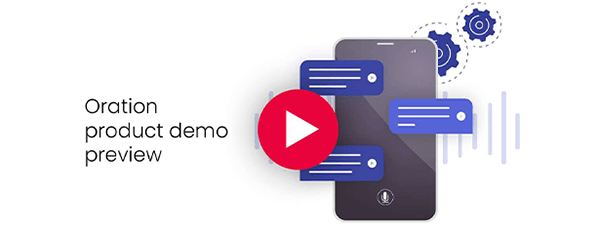Think about a time (most likely at work) when you've received an email from someone discussing complex issues, but you’ve felt entirely lost when it comes to interpreting the intention and emotions behind them. This is because there are no human signals other than the words you read. But exactly how much easier does this get when communicating in person?
We’ve all had experiences where we still struggle to understand the true meaning and sentiment behind the words people speak because, of course, everyone has their own ways of communicating. In fact, it's fair to say that it’s virtually impossible to rely on literal interpretation alone when it comes to conversing with others.
There are so many nuances of verbal communication that can reveal anything from what someone thinks and how they feel, to how serious they are in the conversation. The truth is, some of us are better than others at understanding the hidden signs and messages behind spoken words, but few of us are experts.
With this context in mind, it's not hard to appreciate the difficulties contact centre professionals face interacting with people day in, day out, who have all kinds of different personalities, issues, and reasons for calling. How do you really know when customers are happy and when they are not – and what can you do about it? With 62% of organizations considering customer experience provided through a contact centre environment as a competitive differentiator, how can sentiment analysis help?

What is sentiment analysis?
Sentiment analysis is an AI-powered technology solution used to analyse conversations between customers and agents in real time, with the goal of understanding the emotions and feelings of callers. By recognising patterns in language and identifying positive, negative or neutral sentiments in words and phrases, sentiment analysis can provide a comprehensive picture of the customer's emotional state during the interaction.
Contact centre technologies are becoming increasingly sophisticated when it comes to gathering voice-of-the-customer (VoC) data, with voice recognition technology already integral to delivering the most up-to-date and secure authentication processes. But there is another important use for this type of data which revolves around learning more about customers through their interactions.
When it comes to understanding what sentiment analysis is and how it works on a deeper level, sophisticated algorithms are used to rate words and phrases for their sentiment in the context of the call. They combine this with the unique ability to detect identifiable tones in people's voices which are indicative of a person’s hidden emotions and feelings about the conversation in play.
For example, aside from flagging words with positive, negative or neutral sentiment, sentiment analysis algorithms will be attuned to a variety of different cues. These cues might include the speed at which a person is talking, changes in the tone of the speech or caller and agent talking over each other all of which might indicate rising stress levels, frustration or even happiness or satisfaction.
Ultimately, the outcome of sentiment analysis in the contact centre environment is that contact centre managers have real-time and historical visibility over the sentiment of callers speaking with agents. This is usually offered by an intuitive dashboard that indicates where positive interactions are taking place, and perhaps most importantly, where a conversation may be turning sour.
With this type of visibility, contact centre managers can offer help where required. They can even spot trends that might indicate common issues with customer services or products, so measures can be put in place to drive improvement.

Top benefits and uses of contact centre sentiment analysis
With an understanding of what sentiment analysis is and how it works on a technical level, here are some of the key practical advantages of implementing sentiment analysis capabilities in your contact centre.
- Boosts post-call survey data and adds credibility
Unfortunately, not every caller will take the time to complete a post-call survey probing into their satisfaction with the customer experience. Even when customers do complete surveys, there is no real guarantee that the responses they provide are well-considered or honest enough to be credible sources of actionable insights.
Notwithstanding the usefulness of most post-call surveys, sentiment analysis data around calls can supplement post-call surveys, showing up any inconsistencies but most importantly, common themes which add weight to the customers’ survey responses. For those customers who don't have time to respond to survey questions, sentiment analysis means you are able to capture more data about your customer service interactions without requiring any effort on the part of your callers. - Recognise the performance of agents
Without listening to every call, it's impossible to know how effective different agents are at handling different types of queries. Contact centre sentiment analysis allows you to identify agents who are continuously creating positive experiences on the phone for customers, so they can be rewarded.
Sentiment analysis might also be used to spot strengths and weaknesses among agents when it comes to handling different types of calls. This can be useful in ensuring calls are routed to the best possible agents based on their skills. For example, you might see patterns emerge where an agent consistently performs strongly when handling particular issues, while other issue types tend to provoke negative sentiment. - Improve products or services
Sometimes, the sentiment of customers on the phone will have nothing to do with how your agents are handling the call. In many cases, customer emotions and opinions will be driven by the context around the call, such as their experience with the products or services that they are calling about.
Regardless of the agents handling calls, sentiment analysis insights in the contact centre can reveal common trends when it comes to customer satisfaction with specific products and services. And with 95.7% of contact centre leaders and employees believing customer satisfaction to be the most important measure for success in a contact centre environment, this could be a game-changer.
With this information, businesses can review calls relating to products or services which cause the most negative sentiment to find out what the specific issues are and determine how they can make improvements. Take the example of a past controversial campaign for a product that received mixed reviews. A sentiment analysis was performed and, while there were negative opinions, the overall sentiment was more positive than negative. - Tracking long term business performance
Sentiment analysis data captured over a long period of time can reveal critical information about how your business is performing. For example, if negative customer sentiment becomes increasingly prominent and sustained, this could be an important indication that something is going awry in your approach. This can signal to leaders that there is work to be done to rebuild the reputation of the brand – before the business begins to lose customers to the competition. - Informs agent training programs
When reviewing calls with customers who have exhibited negative sentiment over the phone, it will be possible to identify any issues with agents’ call handling techniques. Focusing on how agents respond to customers displaying negative sentiment might reveal gaps in their knowledge, inappropriate use of language or tone, or other communication issues – all of which can contribute to frustration and dissatisfaction among callers.
A 2021 study analysed airline reviews and revealed that the most negative sentiments received were associated with delays and timing. With these insights, contact centre managers can adapt training programmes to improve the techniques and performance of agents handling different types of calls, consequently building better customer relationships. - Building customer profiles
Sentiment analysis technologies can allow contact centres to get to know their customers better by building profiles of their customers, both on a personal level and by customer segment. In practice, this means you can flag and monitor customers who consistently appear to display negative sentiment, which might determine how calls are routed to specific (or more senior) agents in future.
What’s more, customers who are most positive as identified by sentiment analysis data might be a great source of testimonials or case studies to support the business and brand.
Aside from profiling individual customers, you can also use sentiment analysis data to identify common qualities between groups of customers who appear to have similar experiences and sentiments. For example, if it turns out that most negative sentiment is coming from older age groups, then this might be a sign that your customer services, products or services aren’t meeting the needs or doing enough to target this specific customer segment.

What is sentiment analysis: the different approaches to gathering data
Artificial intelligence and machine learning technology is crucial to the sentiment analysis process. Sophisticated algorithms are designed and continually developed to enable software to accurately identify and pick out language that carries sentiment. With this capability, contact centres are continually training their technology to accurately identify the sentiment of callers from their own natural use of language, irrespective of their communication style and personality.
Sentiment analysis can also be supported by the ‘lexicon’ method. This is where words and phrases are given a sentiment score, so the system is essentially pre-programmed to assess the content of a person's speech and provide an overall sentiment score.
The downside of this approach however, is that the technology is not equipped to recognise and score words and phrases that do not already exist in sentiment lexicons. On the other hand, machine learning techniques enable sentiment analysis technology to assess every spoken word and sentence for its sentiment - however, they’re put together.

Conclusion
Although a relatively new technology, more and more contact centre professionals are asking the question: “What is sentiment analysis, and how can it be used in the contact centre environment?”.
Simply, sentiment analysis in the contact centre brings a multitude of benefits that enhance the customer experience and contact centre operations. From knowing what your customers are really thinking about your customer services to tracking the ongoing performance of your business and products or services, this sophisticated yet easy to implement feature could go a long way to building an agile and more responsive operation in a changing market.







